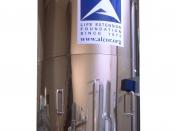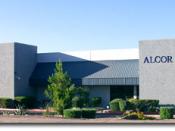The Frozen People Suzie Q, a twenty-five year old woman, is dying of AIDS. When she learned this, she heard about something called cryonic suspension. A cryonist at the hospital where she gets treatment told her how cryonics freezes people when they are pronounced dead. When the cure for AIDS is developed, she would then be revived and able to start a new life. Suzie Q decided to participate in cryonic suspension and spent her life savings to pay for the freezing process. Five years later, Suzie Q died. The cryonics team flew her to an Alcor Life Extension Foundation where she was frozen. Suzie Q's family did not know about her plans and were extremely upset because they felt it was impossible to conduct a proper funeral without a body to bury.
Cryonics what a funny word yet the meaning of this funny word is extremely serious. In Newsday Sidney C.
Schaer a news writer wrote this, "THE WORD 'cryonics'- the practice of freezing a dead body in hopes of someday reviving it- didn't enter the dictionary until 1967. But 200 years earlier, Ben Franklin was dreaming of a frozen ride to immortality" (Schaer). Cryonic suspension requires that the body's temperature be lowered to -196 degrees Celsius or the same as liquid nitrogen. Then the body or head is stored in a dewar, which is like a thermos, and put into cold storage. "This flask is continuously being filled with liquid nitrogen because the nitrogen is evaporating continuously to keep the temperature low" (Cryonic). The cryonic medical team will only reanimate the patients when the cure for what killed the patient is found. Although cryonics is a medical science break-though, it should be outlawed in the United States for several reasons. Cryonic suspension could cause over population and wasted money, cell damage and the patients could possibly be used as guinea pigs, and how will they adapt to the future? Obviously, people are interested in cryonics because it will prolong their life. In the near future, there will be cures for diseases such as AIDS and cancer. Cryonics would be able to give a frozen person with such diseases a chance to be eventually cured. Cryonics would prolong life not only to the age of eighty, but possibly to about one hundred and twenty. "Imagine the chance of being reunited with the people you care about, in the future of exciting possibilities" (What). A life in the future may hold exciting new developments; however, the science of cryonics has not been successfully proven to be effective. "Today, a tiny group of biologists is still trying to bring cryonics 'to its perfection.' A far larger group of debunkers; however, says cryonics is little more than bogus science, its promise, they say, will never be fulfilled." (Schaer). Therefore, today's society should not be able to invest in and/or participate in cryonic suspension until it has been proven to be successful and without side effects.
The first reason cryonic suspension should not be used is because of the overpopulation it will cause if and when the patients of Alcor are all revived. Cryonics has been in place since the 1960's, and there are still no successful reanimation plans to prove it will work. Thus, suspended people will probably be frozen for at least one hundred to two hundred years. Many of the patients could be revived at or around the same time. The patients so far are all adults, and therefore, will all move into the work force and the community together. By the time reanimation occurs, there could be thousands of patients in suspension. The majority of cryonicly suspended patients will be left with no immediate family or friends, and would have no place to live. Not to mention that isolation could cause problems of homelessness and unemployment. Everybody has seen the zillions of advertisements for starving children and adults. This problem has no current solution, and as a result the homelessness and unemployment increase every year. The Alcor patients could also be extremely confused and probably a bit scared. Today's society should not be allowed to participate in cryonics until these problems are realized and solutions are considered. In addition to the overpopulation it will cause, cryonic suspension should not be allowed because the amount of money required to keep the program going when cryonicists are not even sure their ideas will work. The money comes from the patient's own bank account and insurance policies. Tomas Kellner states that, "â¦suspension providers, such as Alcor require clients to designate the provider as the policy's irrevocable beneficiary to cover all freezing costs. That money cannot be touched by family who feels the deceased's investment is misguided" (Forbes). If in the event cryonic suspension does not work will the patient be finally laid to rest, one hundred to two hundred years later, and will the money in the patient's account go to the foundation that cryonically suspended him or her? In National Review a writer states that, "There are annual dues to pay and when the, ahem, moment comes, a neurosuspension will set you back $50,000; 'whole body' will cost $120,000" (Stuttaford 2). These prices do not include reanimation costs. The fact that cryonicist are not completely sure the process is going to work should be reason enough not to allow this kind of procedure.
Not even an animal has successfully been brought back from suspension to live longer than a few months. Cells and organs may be damaged beyond repair. The skeletal system could be fractured and splintered during the freezing process due to dehydration. When a cell is frozen the delicate structure of it is disrupted. Imagine freezing Jell-O and then thawing it out, it becomes runny and non-edible. Now imagine trying to repair the structure of the eye. Inside the globe of the eye is a substance similar to Jell-O. During the freezing process the cells dehydrate, and then crystallize. "Mike Darwin of Alcor noticed several years ago⦠that every organ of their [suspended patients] bodies suffers cracking from thermal stress during freezing. In particular, the spinal cords suffered several fractures. Thus, whole bodies were not quite as 'whole' as most people presumed" (FAQ 5). The damage caused to the cells could be far too extensive to even attempt reanimation. "The biggest problem is that water seeps out of cells, freezes, and thus expands and forms crystals which can puncture the cells" (Genetic). The scientists/cryonicists will have to test this on a human some day. The fact cryonics has not been proven yet is frightening. They could try to use one of the patients as a guinea pig or lab rat for use in experiments that may never work. "As one leaflet is careful to say, ' we don't know if what we are doing will work" (qtd. in Stuttaford 2). There are already numerous people in deep-freeze without any hopes of being reanimated.
The most important reason cryonic suspension should be outlawed is that a person's body in suspension is negatively affected by the procedure, and the new technology fifty to one hundred years later may not be adaptable to people who are put in cryonic suspension today. After being suspended for one hundred or two hundred years, the shock of reanimation would be overwhelming to the people just revived. The patient will need to learn how to walk and talk all over again if it is at all possible. Muscles, which are not used, lose their stability. The people of Alcor do not go into cold storage where the patients are kept and exercise the muscles of the suspended people. Patients, after being revived, would be in the hospital for months running tests before he/she is actually released. In the Detroit Free Press a writer quoted, "This is not like frozen steaks you can bring back, defrost and eat. These are human bodies. It's just not possible," said Dr L.J. Dragovic, Oakland County's medical examiner."(Cryonics). All the new technology and advances could confuse one who was suspended in the 1980's and reanimated one hundred years later. When the Internet came out a lot of people loved the idea, but the thought of actually having to use it frightened a lot of people who knew nothing about computers in the first place. Imagine waking up to even more technology. Everything will be different in the next one hundred years. For all we know cars could be hovering like in The Jetsons when the last thing the patient remembered is Fred Flintstone using foot power. Our entire way of doing things could change leaving the revived person to fend for them selves in an even bigger world.
Yes, cryonics seems like a good idea. Imagine the possibilities of living in the future where once one could only dream of seeing, and now there is the chance of actually living in it. Unfortunately for these few believers it has not yet been proven effective, and there are too many problems that cryonicists are not working on. All they are thinking about is eventually reviving a patient and betting on the technology to be there when needed. As Arthur Rowe boldly stated, "believing in cryonics could reanimate somebody who has been frozen is like believing you can turn hamburger back into a cow" (qtd. in Stuttaford 2). Therefore cryonics should not be used until there are answers to all the unanswered questions. "There are some who say that knowledge gained through science 'dehumanizes' life by shining a harshly dispassionate light on the unknown, on mystery" (Hoagland 149). Cryonics is skimming the edge of science fiction and nothing more.
Suzie Q has now been rejuvenated for five years, and now all she dreams of is dying. She has been set free among a world of no familiar family, and no idea how to use the new technology in this new world. It is so frightening to look outside and expect a world seen only in memories, and see a world one could never even imagine existing. First AIDS caused Suzie Q's pain, now the pain is caused by cryonics. Now she must wait for death to come again.
Works Cited http://www.public.iastate.edu/~'hood/cryonics.html.Cryonics: Adding Years to your Life. 3 December 2001.
http://www.dse.nl/~hkl/e_cryo.htm: Cryonic Suspension. Henry Kluytmans. November 16, 2001.
"Cryonics: Frequently Asked Questions List" (FAQ). Oxford University Libraries Automation Service. 29 January 1995. 27 November 2001.
http://www.freep.com/news/latestnews/pm1453-200012115.htm: Cryonics still has believers. Friday, December 15, 2000. December 18, 2001.
http://www.babesinspace.net/report/reports/2000-04-17.html: Genetic Engineering and Cryonic Freezing: Thoughts Inspired by Frankenstein. Harley Geiger and Bryan Osborn. April 17, 2000. November 29, 2001.
Hoagland, Mahlon B., The Roots of Life A Layman's Guide to Genes, Evolution and the Ways of Cells. Boston: Houghton-Mifflin, 1978, p. 149.
Schaer, Sidney C. "Long Island: Our Future/ Back to the Future/ Cryonics in a Deep Freeze/ Predictions from the Past that Haven't Come Trueâ¦Yet." Newsday 5 Feb. 1999: A19 Online. America Online. 11 May 1999. 16 November 2001.
Stuttaford, Andrew. "Frozen Future." National Review (2 September 1996): n. page Lamp. 26 April 1999.
http://www.alcor.org/01b.html What We Do Cryo Transport and The Alcor Life Extension Foundation. 16 November 2001.





